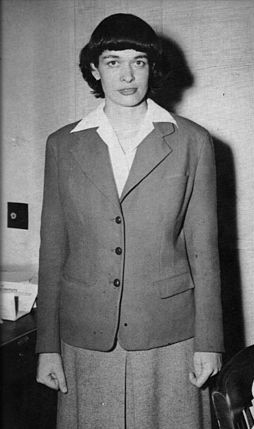The People Who Built the Atomic Bomb

The Enola Gay, the Boeing B-29 Superfortress that dropped the atomic bomb on Japan in World War II, in the Smithsonian National Air and Space Museums Steven F. Udvar-Hazy Center J. Scott Applewhite/AP
A new website assembles thousands of biographies and oral histories from the Manhattan Project.
I could just tell you about Leona Woods Marshall Libby.
I could tell you about how, at 23 years old, she was one of the youngest people to work on the Manhattan Project. And how she was the only woman at Hanford, the first full-scale plutonium reactor in the world, where she worked as a physicist. And how, in 1943, she wore baggy clothes to hide her pregnancy so that her bosses wouldn’t force her to stop working.
I could tell you how, after the war, Leona Libby worked as a particle physicist and environmental scientist, publishing more than 200 scientific papers and several books. And how she contributed important work to the fields of chemistry, astronomy, geophysics, environmental studies, and—of course—physics.
But it’s a better story when Libby tells it herself. Though she died in 1986, you can hear Libby talk about her life’s work in an oral history on the Atomic Heritage Foundation’s website. Her page is one of more than 10,000 biographies and counting in a new project to catalogue the half-million people who contributed, in some form or another, to the Manhattan Project.
“Those 600,000 people, that includes everybody who signed in even just for a day, like construction workers at Hanford,” said Cynthia Kelly, the foundation’s president.
So far, the project includes 370 oral histories. Kelly calls it “a labor of love.”
The historical value is clear. Even though a huge number of people contributed to the Manhattan Project, the work of the scientists involved at the time was kept top secret. The resulting atomic bombs, two of which were dropped by the United States on Japan in 1945, forever changed the course of human history.
Not just because of the outcome of World War II, but because of how the threat of nuclear war has shaped global politics and culture. It’s reasonable to expect that historians hundreds or even thousands of years from now will look back to the development of the atomic bomb as a crucial moment for our species.
The interview with Libby was conducted by the writer Stephen L. Sanger, 30 years ago, in her office at UCLA. One of the most delightful exchanges comes at the very beginning of Sanger’s tape, as he gingerly asks her about what it was like to be a woman working with all men in the 1940s. Here’s how it went:
Sanger: I was just curious if you had any particular, if anybody took note of the fact you were a woman, did you have any—
[Libby laughs]
Libby: What do you mean? That’s a dumb thing to say.
Sanger: —problems, or, I mean, were you treated differently, or not? I know you mentioned that you had a separate restroom at Hanford.
Libby: Yeah, it wasn’t that fun...
Sanger: I was just curious. I mainly wanted to check that you were—
Libby: a woman?
Sanger: —the only woman at Hanford.
Libby: Yes.
Sanger: Except for, I suppose—
Libby: Secretaries.
She’s pretty hard on him! It’s moments like these, vignettes that seem to capture bits of Libby’s personality, that underscore the value of the foundation’s database of Manhattan Project workers. Much of the interview continues this way. Libby is quick to laugh, but not agreeable for the sake of making her interviewer comfortable. She’s witty, and she’s matter of fact.

She also describes herself as unconflicted about her role in creating the most destructive weapon on the planet. As a physicist during the war, there was a “persistent and ever-present fear” that the Germans would build a nuclear bomb first.
“So I have no regrets,” she said. “In war time, it was a desperate time. I think we did right, and we couldn’t have done differently ... When you’re in a war to the death, I don’t think you stand around and say, ‘Is it right?’”
Not everyone felt that way, obviously. Libby’s mentor, the physicist Enrico Fermi, “shouted at her for a good 20 minutes,” when she challenged his reluctance to pursue a hydrogen bomb, according to an article in the Bulletin of the Atomic Scientists in 1980. (“Later, he regretted his decision and on his deathbed told her he had been ‘hypnotized’ and had made a mistake,” the Bulletin wrote.)
Besides, Libby told Sanger, what’s the use in questioning something that’s already happened?
“You can’t stop it. How can you stop it?” she said. “The do-gooders and the crying on shoulders, these guys have got blue-eyed optimism that is not useful.”
“I don’t believe in ends of anything.”


